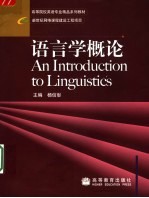图书介绍
语言学概论pdf电子书版本下载

- 杨信彰主编;刘承宇,李力编 著
- 出版社: 北京:高等教育出版社
- ISBN:7040159872
- 出版时间:2005
- 标注页数:307页
- 文件大小:54MB
- 文件页数:321页
- 主题词:语言学-概论-高等学校-教材
PDF下载
下载说明
语言学概论PDF格式电子书版下载
下载的文件为RAR压缩包。需要使用解压软件进行解压得到PDF格式图书。建议使用BT下载工具Free Download Manager进行下载,简称FDM(免费,没有广告,支持多平台)。本站资源全部打包为BT种子。所以需要使用专业的BT下载软件进行下载。如 BitComet qBittorrent uTorrent等BT下载工具。迅雷目前由于本站不是热门资源。不推荐使用!后期资源热门了。安装了迅雷也可以迅雷进行下载!
(文件页数 要大于 标注页数,上中下等多册电子书除外)
注意:本站所有压缩包均有解压码: 点击下载压缩包解压工具
图书目录
Chapter 1 Language and Linguistics 1
1.1 The Nature of Language 1
1.1.1 Language Is Systematic 2
1.1.2 Language Is Symbolic 3
1.1.3 Language Is Arbitrary 6
1.1.4 Language Is Primarily Vocal 7
1.1.5 Language Is Human Specific 10
1.1.6 Language Is Used for Communication 12
1.2 The Functions of Language 14
1.2.1 General Functions of Language 14
1.2.2 Metafunctions of Language 18
1.3 The Origin and Classification of Language 20
1.3.1 The Origin of Language 21
1.3.2 Language Families 24
1.4 What Is Linguistics? 26
1.4.1 Definition of Linguistics 27
1.4.2 Some Important Distinctions in Linguistics 29
1.5 The Scope of Linguistics 35
1.5.1 Use of Linguistics 35
1.5.2 Recent Developments 38
Chapter 2 Phonetics and Phonology 43
2.1 Production of Sounds 43
2.1.1 Scope of Phonetics 43
2.1.2 Articulation of Sounds 45
2.1.3 Characteristics of English Speech Sounds 51
2.1.4 The Transcription of Sounds 54
2.2 Phonemes 56
2.2.1 Definition of Phonemes 56
2.2.2 Minimal Pairs 58
2.2.3 Distinctive Features 60
2.3 Sound Patterns 62
2.3.1 Sequential Constraints 62
2.3.2 Complementary Distribution 64
2.4.1 Syllable 65
2.4 Suprasegmental Features 65
2.4.2 Stress 67
2.4.3 Pitch 69
2.4.4 Intonation and Tone 70
Chapter 3 Morphology and Lexicon 73
3.1 Word and Word Classes 73
3.1.1 Word 74
3.1.2 Word Classes 75
3.2.1 What Is a Morpheme? 81
3.2 Morpheme 81
3.2.2 Types of Morphemes 83
3.3 Inflection and Word-formation 85
3.3.1 Inflection 85
3.3.2 Word-formation 86
3.4 Lexicon 91
3.4.1 Lexeme 91
3.4.2 Features of Lexicon 93
4.1 Sentence Structure 97
Chapter 4 Syntax 97
4.1.1 Constituents 98
4.1.2 Sentence Types 100
4.2 Syntactic Function and Category 104
4.2.1 Syntactic Function 104
4.2.2 Category 108
4.3 Transformational Rules 111
4.3.1 Deep Structure and Surface Structure 111
4.3.2 Sentence Transformations 115
Chapter 5 Semantics 123
5.1 Approaches to Meaning 123
5.1.1 Meaning 124
5.1.2 Three Approaches to Meaning 129
5.2 Semantic Field and Semantic Relations 134
5.2.1 Semantic Field 134
5.2.2 Synonymy and Antonymy 136
5.2.3 Meronymy and Hyponymy 140
5.2.4 Polysemy and Homonymy 142
5.2.5 Intersentential Semantic Relations 146
5.3 Semantic Analysis 151
5.3.1 Componential Analysis 151
5.3.2 Predication Analysis 154
5.3.3 Tautology and Metaphor 157
Chapter 6 Pragmatics and Text Analysis 161
6.1 Speech Act Theory 162
6.1.1 Speech Act 162
6.1.2 Indirect Speech Act 166
6.2 The Cooperative Principle and the Politeness Principle 169
6.2.1 The Cooperative Principle 169
6.2.2 The Politeness Principle 173
6.3 Presupposition and the Structure of Spoken Text 177
6.3.1 Presupposition 177
6.3.2 Exchange and Adjacency Pair 181
6.4 Cohesion 184
6.4.1 Reference 185
6.4.2 Substitution and Ellipsis 188
6.4.3 Conjunction 192
6.4.4 Lexical Cohesion 194
6.5 Thematic Structure and Information Unit 197
6.5.1 Theme and Rheme 197
6.5.2 Given and New 200
7.1 Language Varieties 203
Chapter 7 Language and Social Culture 203
7.1.1 Dialect 204
7.1.2 Register 208
7.1.3 Ethnic Varieties 209
7.2 Language and Culture 211
7.2.1 The Relationship Between Language and Culture 211
7.2.2 The Study of Language and Culture 213
7.3 Language Change 215
7.3.1 Causes of Language Change 215
7.3.2 Lexical Change 218
7.3.3 Sound Change 221
7.3.4 Syntactical Change 222
7.4 Language Planning 223
7.4.1 Standard Language 224
7.4.2 National Language and Official Language 225
Chapter 8 Language Acquisition and Thought 227
8.1 First Language Acquisition 227
8.1.1 Difference Between Acquisition and Foreign Language Learning 227
8.1.2 Development of First Language Acquisition 229
8.2 Second Language Acquisition 233
8.2.1 Major Features of Second Language Acquisition 233
8.2.2 Internal and External Factors 236
8.3 Language and Thought 239
8.3.1 The Relationship Between Language and Thought 239
8.3.2 Psychological Realities 241
9.1.1 An Overview of Language Teaching 247
9.1 Approaches to Language Teaching 247
Chapter 9 Linguistics and Language Teaching 247
9.1.2 The Relation of Linguistics to Language Teaching 249
9.2 Syllabus Design 253
9.2.1 Grammatical Syllabus 254
9.2.2 Situational Syllabus 255
9.2.3 Communicative Syllabus 257
9.3 Language Testing 258
9.3.1 An Overview of Language Testing 258
9.3.2 Basic Considerations 261
9.3.3 Types of Language Tests 262
9.3.4 Language Test Development 265
9.4 Error Analysis 269
9.4.1 Some Basic Concepts 269
9.4.2 Methods of Error Analysis 272
Further Readings 275
References 293
Glossary 299